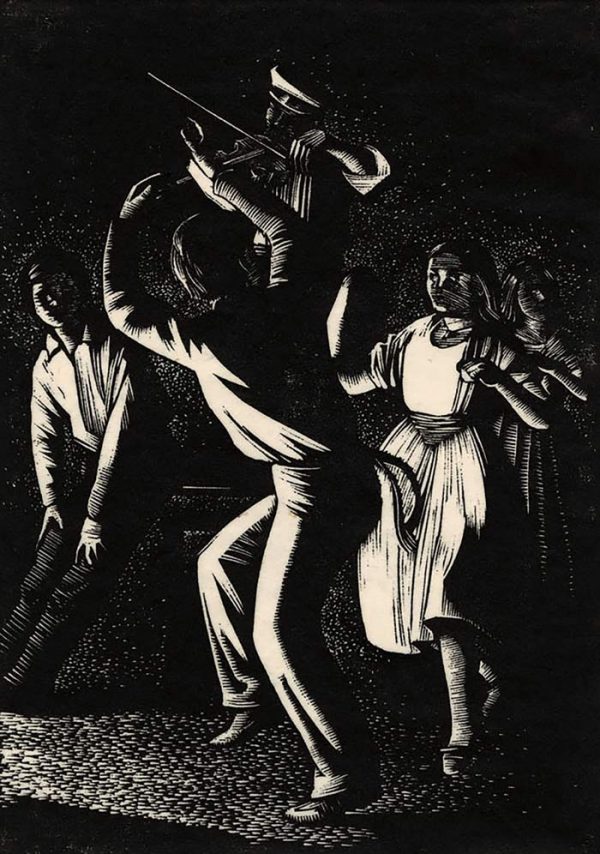Music and Dance
The Metis have always been a social and festive people with a love of song and dance, blending their First Nations and European ancestral cultures into unique fiddle playing and dance styles. As Europeans brought violins to North America, the Métis embraced the instrument and began playing and making their own tunes, often mixing First Nations, Scots and French-Canadian rhythms, but with unique beats. These new songs also led to the creation of new dances. Later, other fiddling traditions from English-speaking North America also contributed to Métis fiddling.
Métis jigging originated in the Red River area. It is a combination of First Nations dancing and Scottish and French-Canadian step-dancing, and reel, jig and quadrille steps. Some of the more popular jigs are the “Red River Jig,” the “Rabbit Dance,” the “Broom Dance” and the “Sash Dance.”
The first recorded reference to the “Red River Jig” was in 1860, when Mr. Macdallas played the tune for the wedding dance of a Métis couple. Father Père Brocher, who conducted the marriage ceremony, named the tune the “Red River Jig.” This song, along with the French-Canadian tune, “La Grande Gigue Simple,” is a variation of the Scottish tune by Peter Milne entitled “Big John McNeil.” The “Red River Jig” is played at almost all Métis functions.
Métis fiddlers are cultural ambassadors, travelling throughout North America to take part in ‘old time fiddle’ contests such as the John Arcand Fiddle Fest, held near Saskatoon.
Accounts by missionaries and fur traders and artists’ sketches indicate that the sociable Red River Métis were passionate about fiddling, dancing and celebrating. A Red River ball, with numerous fiddle players and callers, was the social highlight of the year, and was attended by all the local Métis. Fiddling within Métis society was egalitarian, since both the elite and the rank and file enjoyed playing the instrument. Every Métis family had a fiddle player. Fiddles were often handmade from maple wood and birch since most Métis could not afford ready-made ones. Despite the lack of formal training, many Métis became master fiddle players. For instance, William Arcand, a Métis originally from Saskatchewan, played for the Queen Mother in England. Two Manitoba Métis fiddlers, Andy DeJarlis and Eugene Laderoute, who composed the popular “Keystone Reel,” were famous throughout the world.
Métis fiddlers are cultural ambassadors, travelling throughout North America to take part in “old-time fiddle” contests such as the John Arcand Fiddle Fest, held near Saskatoon, Sask. The Métis also hold many competitions to determine the best jiggers and square dancers. Each performer has developed unique steps. Over time, a person’s steps change from watching other jiggers, or by simply inventing them. To be a good jigger, your upper body has to remain straight while you perform steps with your feet. Some people can even tell where a person is from based on their steps. Each community and some families have unique jigging styles. Fiddle music, jigging and step-dancing are celebrated at social and cultural events in communities across the Métis Nation Homeland. At present-day Métis celebrations, such as Back to Batoche (Batoche, Sask.), Métis Fest (St. Albert, Alta.) and the John Arcand Fiddle Fest, there is a great deal of fiddle playing and dancing.

Métis Songs
The first recognized composer of Métis songs was Pierre Falcon (1793-1876). His song, “La Bataille des Sept Chênes” or “La Chanson de la Grenouillère” (“The Battle of Seven Oaks” or “The Ballad of Frog Plain”) was sung by the Métis for at least three generations. Falcon’s songs are mainly about the Métis’ martial prowess and their bison-hunting lifestyle. His songs were handed down through the Oral Tradition and as a result, many variations exist.
The Métis also sang songs to keep their spirits high during times of crisis. For instance, during the 1885 Northwest Resistance, at the Battle of Fish Creek (April 24, 1885), the Métis sang “La Bataille des Sept Chênes,” and “Malbrouk.” Louis Riel wrote a song entitled “C’est au Champ de Bataille” (The Battlefield), also known as “De Tous Champs de Bataille” or “L’adieu de Riel” (“Riel’s Farewell”). Written prior to his execution on Nov. 16, 1885, it is a haunting song about the terrible sacrifice which war brings to its participants. Riel also wrote a song called “La Métisse” (“The Métis Girl”) that salutes the piety and patriotism of the Métis women during the Red River Resistance.
Square Dancing
The Métis are widely known for their square dancing. During a square dance, four couples face each other and dance with one another in a square formation. It is believed that many forms of Métis dance grew into the very popular square dancing style of today. These dances are infinitely more complex than jigs because they require participants to work as couples and to follow a dance caller’s directions. The dance caller uses panache, creativity, humour and musical knowledge to ensure that people stay in time with the music and enjoy themselves. Good callers can keep a dance going well into the morning.
The most famous Métis dance is the “Red River Jig,” or as it is known in Michif, “oayache mannin.” The accompanying fiddle tune, which was very popular in the mid-1800s and was known from Alaska to James Bay, is based on the song “Big John McNeil” from Scotland. French-Canadians played a variant fiddle tune entitled “La Grande Gigue Simple.” The “Red River Jig” is a combination of Plains Indian footwork and Scottish, Irish and French-Canadian dance forms such as stomps, quadrilles, reels and jigs. The basic jig step is danced in most Métis communities. However, dancers often add their own “fancy” dance steps during certain segments of the tune. Some dancers use fancy steps to identify their home community. In 1940, Métis fiddler Frédéric Genthon made the first recording of the “Red River Jig” for posterity.

Order now
from Amazon.ca or Chapters.Indigo.ca or contact your favourite bookseller or educational wholesaler




